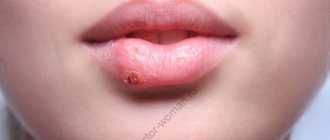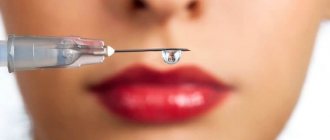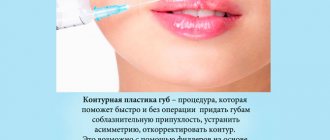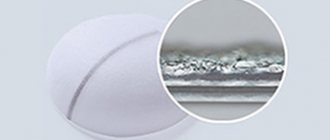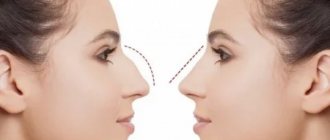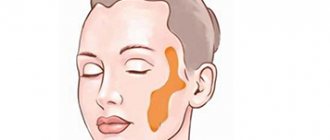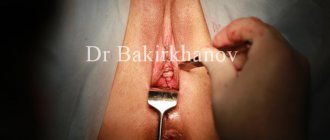Most women have thought about lip augmentation at least once in their lives. Not everyone is ready to go under the surgeon's knife. Thanks to the development of cosmetic medicine, this is no longer necessary. Modern techniques allow you to give your lips the required volume or adjust their shape using injections. We are talking about lip contouring.
Although this is not an operation, you should still carefully choose a specialist for the procedure. Such manipulations in aesthetic medicine require knowledge of anatomy, physiology, as well as skill in administering injections using certain techniques. This service is available in beauty salons. Typically, the cost of procedures in such institutions is lower than in medical centers. Contour plastic surgery can be done by people without the necessary knowledge and experience. Our cosmetology clinic “Cleo Line” takes care of you and your comfort. We employ professionals in their field, doctors with extensive practical experience and a huge amount of medical knowledge.
Remember: by saving on the procedure, you can pay dearly in the future not only with your beauty, but also with your health.
Why should you consult a cosmetologist?
Lip contouring seems like a simple manipulation. In fact, the procedure has its own subtleties, if not followed, the result may not only not please the patient, but even disfigure the face. Filler injections must be performed by a qualified professional. By saving on the procedure, you may end up with an incompetent or inexperienced specialist, which will lead to a disastrous result. The low cost of the service may be due to cheap material, as well as savings on tools or their processing.
For a clear example, let’s look at the top 10 possible complications when performing lip contouring. First, let's talk about those related to the unprofessionalism of cosmetologists.
What don't women like?
When we talk about unsuccessfully inflated lips, we do not necessarily mean life-threatening migration of the gel or inflammation of the lips, which the biopolymer injection procedure can actually lead to. Most often, women who want to correct unsuccessful lip augmentation are unhappy with the way their lips look.
How so? It would seem that I wanted plump, voluminous lips - here they are, live and be happy. But you can’t be happy, because the result is not at all what was expected.
Why do unsuccessful lip injections often not live up to expectations?
Huge lips
A competent cosmetologist knows how to assess the condition of tissues and the required volume of the drug. Without this skill and experience, you may accidentally inject an excessive amount of filler. Were you expecting plump, beautiful lips, but what came out was huge rollers covering half your face? Unfortunately, you were given too much of the drug. The effect of fillers lasts up to 1 year. In cosmetology centers, similar mistakes of other masters can be corrected with the help of special enzymes. It should be noted that the possibility of correcting the defect depends on the composition of the drug. In some cases, it is impossible to do without the intervention of a surgeon.
Contour plastic with fillers
The procedure involves injecting special medications into the lips through a thin needle. The injection technique may vary, and the choice of method depends on the type of filler and the desired result, which are determined individually.
Drugs that allow you to correct the contour and volume of the lips without surgery are called fillers. These are fillers that change the shape of soft tissues and complement the missing, lost volumes. Most often, fillers are used based on hyaluronic acid, which is a natural component. The substance does not cause allergies or side effects, is well distributed in tissues and is absorbed in the body over time.
Corrective drugs must be certified. Most often in aesthetic medicine clinics and beauty salons they use Juvederm, Surgiderm, Belotero, Perlane, Restylane. In addition to preparations with hyaluronic acid, fillers based on collagen, calcium hydroxyapatite, polylactic acid and many other substances are also used.
The procedure takes place in several stages:
- Anesthesia. The injections do not cause too much discomfort, but for patients with increased sensitivity, injection or surface anesthesia is used.
- Introduction of filler. Key stage of the procedure. The gel is injected through a thin needle, which evenly distributes the drug at a depth of about 2-4 mm.
- Massage. To avoid the formation of lumps, the specialist performs a light massage.
You can go home immediately after the procedure. The recovery period takes up to 5 days. During this time, the swelling goes down and the bruises disappear. In some cases, the specialist prescribes healing ointments or cold compresses.
Before you make your lip contour clearer with fillers, it is important to consider that the effect of the procedure is quite short-term. On average, the result lasts about 6 months, only in rare cases it lasts up to one and a half years. After 6-9 months, the procedure must be repeated. However, injections should not be given too often, as scars may appear as a result of the needle injuring the delicate skin.
Violation of facial proportions
Before lip augmentation, the cosmetologist will listen to your wishes and give his recommendations. When translated into reality, our desires do not always meet our expectations. Excessively large lips can disrupt the harmony of facial proportions. A mouth that is too large is not perceived as something beautiful. Before the procedure, an experienced specialist designs the expected result, taking into account the features and proportions of the face.
Answers to popular questions
To study the situation in more detail, we recommend that you read the answers to popular questions. Additionally, you can contact your doctor and clarify with him the nuances of interest. Our specialists provide comprehensive support. They work with patients both before and after the procedure. The cosmetologist ensures that the patient receives care. He clarifies all the details. As a result, the occurrence of effects is reduced.
How long does it take for lips to heal after augmentation?
Recovery takes 1 to 2 weeks. However, everything is individual. The speed of recovery is affected by proper care. If the patient uses healing and soothing ointments, discomfort will decrease, swelling will subside faster, and the recovery procedure will take less time. However, the funds can be selected together with your doctor. Specialists will find out which drugs can be used in a particular case, and then prescribe the appropriate medication.
Is it possible to drink alcohol after lip augmentation?
Drinking alcohol during the entire healing period is strictly prohibited. This is due to the fact that it has a thinning effect on the blood. As a result, extensive hematomas may appear that do not look very aesthetically pleasing. Additionally, there is a risk of developing other negative reactions. Because of this, it is recommended to refrain from drinking alcohol.
Kissing after lip augmentation
The pain persists for the first few days. Therefore, kissing can bring physical discomfort. It's better to avoid them. When the swelling subsides and the discomfort disappears, they are acceptable. However, it is best to refrain from excessive activity until healing is completely complete.
Is it possible to play sports after lip augmentation?
Physical activity increases sweating and increases blood pressure. All this negatively affects the healing process. As a result, the likelihood of infections and side effects increases. Therefore, it is not recommended to exercise for at least one week. It is better to postpone going to the gym until healing is complete.
Is it possible to smoke after lip augmentation?
Smoking is also included in the list of prohibited activities. In the first days, holding a cigarette with your lips will be uncomfortable. This will significantly increase discomfort and also slow down healing. The risk of side effects will also increase significantly. Therefore, during the recovery period after lip augmentation, smoking is prohibited.
Violation of lip proportions
The aesthetics of the lips is based not only on their overall volume, but also on other criteria. Leonardo Da Vinci's research into ideal beauty relied on the importance of proportions. Every professional cosmetologist follows his rule of the golden ratio. It is important to consider the ideal lip ratio. The upper lip should be 1/3 in volume, and the lower lip 2/3. A violation of these proportions immediately catches the eye and the face loses its attractiveness. Before starting the procedure, the doctor must take into account that the lower lip in profile should be larger than the upper lip, and select the necessary filler dosages for each separately.
Why does facial asymmetry occur?
Physiological conditions
Slight static (visible at rest) facial asymmetry is a physiological norm and occurs in almost all people.
A difference in proportions within 3-5 degrees or 2-3 mm is considered normal. Sometimes visually noticeable differences between the halves of the face are aggravated by facial features. This asymmetry (noticeable during tension of the facial muscles) is called dynamic. The differences tend to worsen with age as a person repeatedly tenses the same muscles asymmetrically. This affects the condition of soft tissues and the formation of wrinkles.
Damage to cerebral structures and meninges
Facial asymmetry is provoked by traumatic injuries and diseases of the central nervous system of various origins. The list of pathologies includes:
- Compression of the brain.
Acutely develops as a result of severe head injury, cerebral edema. Gradually progresses with hydrocephalus, tumors, cystic formations located in the cranial cavity. - Stroke.
Occurs acutely against the background of arterial hypertension, atherosclerosis, angina pectoris. May be ischemic or hemorrhagic. The outcome of both variants of pathology is focal brain damage, causing disturbances in nervous regulation and facial asymmetry. - Encephalitis.
Focal disorders are a consequence not only of circulatory disorders, but also of inflammatory processes in the brain. Facial asymmetry is sometimes observed in patients who have had primary (tick-borne, Japanese mosquito) or secondary (influenza, measles, post-vaccination) forms of encephalitis. - Meningitis.
The cause of symmetry disorder can be the involvement of cranial nerves, the spread of infection to brain structures with the development of meningoencephalitis. The symptom is more often detected with purulent meningitis, basilar tuberculous meningitis. - Neuroleukemia.
Formed as a complication of leukemia. Facial asymmetry can be caused by dysfunction of the cranial nerves, the occurrence of leukemic meningoencephalitis, and compression of brain structures in patients with the pseudotumor form of the disease. - Progressive hemiatrophy of the face.
The gradual reduction of half the face is due to atrophy of bones and soft tissues, presumably caused by an effect on the autonomic centers. Changes appear in a limited area and eventually spread to the entire half of the face. - Oromandibular dystonia.
It is manifested by violent movements: clenching, lateral movements of the jaws, opening and closing the mouth, which are accompanied by curvature of the lips, violation of symmetry at the level of the cheeks. The occurrence of pathology is provoked by damage to the basal ganglia.
Facial asymmetry
Pathologies of cranial nerves
The most common cranial nerve disorder causing asymmetry is facial neuritis. The cause of violation of symmetry is paresis or paralysis of facial muscles. The typical clinical picture includes smoothness of the nasolabial fold, drooping of the corner of the mouth, inability to close the eyelid, and skewing of the face in the healthy direction. A type of facial paralysis is Ramsay-Hunt syndrome. Along with weakness of facial muscles, patients experience ear pain, dizziness, and hearing loss.
In patients with Bogorad syndrome, branches of the facial or abducens nerve grow into the salivary and lacrimal glands. The disease develops at an early age, less often becomes a consequence of injuries in adults, and is accompanied by lacrimation and increased salivation on the affected side. Damage to the facial nerve is manifested by paresis of the facial muscles, the abducens nerve - hearing impairment, deformation of the auricle. In children, facial asymmetry progresses as they grow.
Jaw lesions
A fairly common dental cause of facial asymmetry are diseases, consequences of injuries, congenital anomalies of the jaws and TMJ:
- Arthrosis of the TMJ.
The symptom appears during the process of opening the mouth and is caused by a displacement of the lower jaw to the affected side. The disease develops gradually, accompanied by crunching, clicking, morning stiffness, and dull pain. - Ankylosis of the TMJ.
Facial asymmetry persists at rest and gets worse when trying to open the mouth. The midline of the face is shifted to the affected side. The lower jaw is retracted downwards by no more than 1 cm, horizontal movements are impossible. - Contracture of the lower jaw.
There are restrictions when opening the mouth, a decrease in the amplitude of movements of the lower jaw. The midline also shifts towards the affected side. The pathology can be unstable (inflammatory) or persistent (scarring). - Ameloblastoma.
An odontogenic benign tumor that destroys jaw tissue can reach significant sizes and cause significant facial deformation. The tumor grows slowly, and asymmetry in the jaw area becomes the first symptom of the disease. - Other benign tumors of the jaws
. The symptom is often found in osteomas, osteoid osteomas, and osteoblastoclastomas. - Cancer of the upper jaw.
Deformation occurs when the size of the neoplasia is sufficiently large and is caused by the growth of the tumor itself, the destruction of nearby anatomical structures, and inflammatory edema. - Cancer of the lower jaw.
Facial asymmetry is noted in the case of tumor growth into nearby soft tissues and deformation of the alveolar process.
Another reason for asymmetry is jaw defects, which can be congenital or acquired: resulting from injuries, osteomyelitis, tuberculosis, syphilis, and operations for cancer. In case of a defect of the upper jaw, the symptom appears due to the recession of the cheek, and may be accompanied by the formation of oronasal and oroantal anastomosis.
A defect of the lower jaw is characterized by a violation of the oval of the face. Due to the displacement of the jaw towards the midline, the asymmetry is aggravated during mouth opening. Violation of symmetry is also often manifested by micrognathia - a reduction in the jaw due to underdevelopment or previous damage. With upper micrognathia, the lower teeth overlap the upper ones (reverse overlap); with the lower variant of the pathology, a slanted chin is observed.
Diseases of the salivary glands
Inflammatory processes and space-occupying formations of the salivary gland cause deformation of the lower outer part of the face and cause asymmetry.
- Purulent parotitis.
A rapidly increasing painful swelling appears in the projection of the parotid salivary gland. An increase in temperature and symptoms of intoxication are detected. - Mucocele.
Causes facial asymmetry as a result of damage to the salivary glands located in the parotid and submandibular regions. The swelling is painless, the condition is satisfactory, there are no signs of inflammation. - Cyst.
As in the previous case, the symptom is observed when the parotid and submandibular glands are involved; pain and inflammatory manifestations are not observed. Due to infection, low-grade fever and local soreness are possible. - Adenoma.
Benign tumor with slow growth. As the size increases, along with asymmetry, discomfort and decreased salivation are noted. - Tumors.
Benign lipomas, neuromas, and angiomas form in the area of the salivary glands. Clinical manifestations of the neoplasm resemble an adenoma. The list of malignant neoplasias includes sarcomas and carcinomas, which are characterized by rapid growth and destruction of soft tissue. Pathologies are often accompanied by paresis of the facial nerve.
Other dental diseases
Other inflammatory dental pathologies that can cause facial asymmetry include:
- Periostitis of the jaw (flux).
Only the periosteum suffers, the jaw itself remains intact. Flux is often caused by dental diseases. The cause of asymmetry is local edema, the formation of an abscess under the periosteum. - Periapical abscess.
An abscess forms in the tissues around the root of the tooth, provoked by acute periodontitis. It manifests itself as severe throbbing pain in the area of the affected tooth. Facial deformity is caused by the spread of edema to the surrounding soft tissues. - Perimaxillary abscess.
Develops with dental lesions and inflammatory processes in surrounding tissues. Accompanied by a violation of the general condition, toothache, dense swelling, in the center of which a fluctuation area subsequently forms.
Non-inflammatory causes of asymmetry include crossbite, a condition in which the dentition intersects when the jaws close. May be congenital or acquired. It is characterized by a shift of the chin to the side, recession of the lip on one side, and flattening of the lower parts of the face on the other.
Facial injuries
Temporary asymmetry of the face, caused by swelling of the soft tissues, is observed with soft tissue bruises and facial hematomas. It occurs after a blow or fall, increases rapidly within a few hours, and gradually disappears over 1-2 weeks. At the recovery stage, there is a consistent change in skin color in areas of hemorrhage. In fractures, asymmetry is caused not only by swelling, but also by displacement of the hard structures of the facial skull. The cause of the symptom is:
- Fracture of the lower jaw.
The loss of symmetry is more noticeable along the outer or lower edge of the cheek. A step (discontinuity of the dentition) in the area of the fracture is detected in the oral cavity. - Fracture of the upper jaw.
The face becomes asymmetrical due to swelling in the upper part of the cheek. Hemorrhages in the periorbital area and neurological disorders are possible. - Fracture of the zygomatic bone.
Initially, the swelling is localized in the cheekbone area, and subsequently quickly spreads upward and downward along the outer surface of the face. Periorbital hemorrhages and double vision may be observed.
ENT diseases
Silent sinus syndrome occurs as a result of atelectasis of the maxillary sinus. It manifests itself as a decrease in the volume of the accessory sinus, unilateral deformation of the face: drooping of the lower edge of the orbit, displacement of the eyeball into the orbit, and recession of the cheek. The pathology develops over many years, gradually progresses, and in the final stages is accompanied by ophthalmological disorders.
In patients with cysts of the paranasal sinuses, in contrast to the previous case, asymmetry develops due to excess, and not due to lack of tissue. The symptom is detected only with large cysts and is manifested by unilateral deformation of the forehead or cheek. Pain in the sinus area, dull headaches, and recurrent sinusitis are observed.
Congenital and childhood pathologies
Facial asymmetry is diagnosed in the following congenital diseases and pathologies of childhood:
- Sturge-Weber syndrome.
A congenital disease in which angiomas form on the skin and meninges. With hydrocephalus and hemiparesis, facial asymmetry develops on the side opposite to the location of the angiomas. - Torticollis.
The congenital form is caused by underdevelopment of the sternocleidomastoid or trapezius muscle, while the acquired form is caused by various diseases and injuries. The child's ear, eyebrow and eye on the affected side are lower than on the healthy side. The palpebral fissure is somewhat narrowed. - Lhermitte-Duclos disease.
A genetically determined pathology, the main manifestation of which is a neoplasm of the cerebellum. Even before the tumor begins to grow, the disease can be suspected by asymmetry of the facial skeleton, gum hyperplasia, congenital anomalies of the hands, and some other signs. - Acute intermittent porphyria.
A hereditary disease manifested by attacks caused by disorders of porphyrin metabolism. Facial asymmetry is observed in severe cases, occurs approximately a week after the onset of gastrointestinal symptoms, and is combined with other neurological disorders. - Cleft lip.
A developmental anomaly in which one or two clefts of the upper lip are detected, located on either side of the midline. With an accompanying cleft palate, the deformity is aggravated by a “dip” in the middle part of the face and a violation of the shape of the nose. - Stigmas of embryogenesis.
Violation of symmetry can be determined by a number of small anomalies: changes in the shape of the skull, deformations of the nose, eyes, and dental system.
Other reasons
Other possible causes of facial asymmetry include:
- Hydrogen peroxide poisoning.
The symptom is detected when there is a violation of cerebral circulation, complemented by disturbances in speech, hearing, and coordination of movements. - Actinomycosis.
Asymmetry is observed in maxillofacial actinomycosis and is caused by the formation of an infiltrate in the area of the masticatory muscles and the development of trismus. - Kallmann syndrome.
With this form of hypogonadism, the symptom is caused by developmental defects and minor anomalies of the face, and is combined with eunuchoidism, cardiovascular disorders, and gynecomastia. - Botulism.
Accompanied by facial asymmetry in neurological disorders that cause paresis or paralysis of facial muscles.
Deformation of lip anatomy
There is nothing more attractive than natural beauty. Lips naturally have their own delicate anatomy. Thanks to their smooth curves, lips are attractive. There should be a vertical groove (philtrum) above the upper lip, and a labial tubercle below it. In addition to these anatomical structures, lips have a number of details. Cosmetologists take these nuances into account in their work and do not violate the architectonics of the face. The natural contours of the lips give them an attractive appearance. A self-taught cosmetologist will perform contour plastic surgery cheaper than a specialist in a clinic. However, as a result, instead of beautiful, plump lips, you may end up with two disfigured “pancakes” on your face, spoiling your entire look.
Lip massage after augmentation
It is strictly not recommended to massage your lips immediately after the procedure. This is fraught with infection. You must wait at least a day. It is better to slightly increase this period. However, in general, massage is beneficial. It will help the drug to be evenly distributed on the lips. As a result, the risk of unevenness will be significantly reduced. Additionally, this effect helps restore blood circulation. Overall, it will be possible to significantly shorten the healing period. It is better to massage after the swelling subsides. Until this moment, there is an active recovery period, and massage can cause harm.
Lip eversion
The most striking and memorable mistake of a doctor. The introduction of filler into the mucous membrane area leads to eversion of the lips. Their inner surface becomes visible. The lip seems to “fall out” from the mouth. The mucous membrane is lighter than the surface epithelium. Therefore, such inversions are immediately visible. The first association that comes to mind when seeing such victims of cosmetology is “here’s the poor guy, she/he was stung by a bee right on the lips!” In addition to the issue of beauty, you should also think about the harm to health. The everted mucosa dries out with constant contact with air. Gradually it cracks and can become inflamed. As a result, inflammation of the oral cavity (stomatitis) and lips (cheilitis) develops. Do not inject the drug into the mucous membrane of the lips! A cosmetologist will never make such a mistake, which once again guarantees the safety of procedures in cosmetology centers.
Contraindications after lip augmentation
Lip contouring is considered a safe procedure. After it, you can almost immediately return to your normal lifestyle. The need for care and healing is still present. Although the doctor uses anesthesia, the procedure may be painful. Unpleasant sensations persist in the future. They can follow the patient for up to 3 days. In order not to worsen the condition, it is important to follow a number of recommendations. Thus, the following contraindications apply:
- It is recommended not to eat food for 3 hours. The greatest number of restrictions concerns hot dishes. It is better not to eat them during the day. Otherwise, there is a risk of spoiling the result, as well as injuring the treated area. Therefore, it is recommended to give preference to products at room temperature. Hot and spicy dishes should be excluded from the menu. Eating such food is fraught with inflammation and swelling. It is advisable to cut the food into small pieces. It's better not to open your mouth wide. This increases soreness. On the first day after the procedure, it is highly recommended not to touch the treatment area. This is fraught with infection. It needs some time to heal.
- While your lips are healing, it is better not to use decorative cosmetics. The use of lipsticks, lip pencils, balms, and glosses is prohibited. Their use is fraught with the occurrence of infections.
- Overheating must be avoided. Otherwise, restructuring of hyaluronic acid is possible. It is also better not to use cooling compresses too often. Otherwise, the skin will become excessively dry and microcracks may appear.
- It is recommended to limit physical activity. Also, doctors do not recommend showing facial activity.
- Tanning is banned for one to two weeks. During this period, it is also not recommended to be in the open sun. The above procedures lead to excessive sweating, which increases the risk of infection. Additionally, the development of hyperpigmentation and swelling is possible. All warming procedures are also prohibited. They can lead to the breakdown of hyaluronic acid.
"Duck Mouth"
This is called protrusion of the lips forward. This is another mistake by the master. Duck mouth occurs when an excessive amount of filler is injected into the upper lip. It overflows and becomes longer. Hence the analogy with a duck's beak. Excess hyaluronic acid can be removed using special enzymes in cosmetology centers. When using fillers with another active substance, the work of a surgeon will be required.
Types of lip permanent
In the modern sense, this makeup appeared in the USA and Taiwan in the 80s of the last century, from where it has already spread throughout the world. The essence of micropigmentation technology (as permanent is also called) is the introduction of dye under the top layer of skin through tiny punctures.
Of course, it is important for any woman to improve and become more attractive. But, probably, tattooing acquires its main cosmetic significance in the presence of scars or natural flaws that it helps to hide.
Find out how to use Oriflame eyebrow shadows here.
No shading
More than 30 years of development of this art have led to the emergence of several types of coating, each of which has its own goals:
- Drawing the outline. During the procedure, only the border line is affected, leaving the space without shading. This type of tattoo is the simplest and fastest, and the effect can be completely invisible to the eye or resemble pencil eyeliner.
- Contour with shading. In addition to the drawn border, the artist extends the tone to the inner space of the lips. The fill can be wide or narrow, and the colors vary from darker at the edges to lighter closer to the center.
- Full painting. In this case, the emphasis is on filling the entire space, sometimes even without making a contour. Depending on the chosen tone, you can get a natural but rich coverage, a visible lipstick or even gloss effect.
- Light kajal (natural tattoo). The uniqueness of the method lies in the use of very pale paint, which is applied along the border without shading. The naturalness of this part of the face is preserved as much as possible, but volume is added.
For permanent hair, only natural dyes are recommended, which almost completely eliminate the risk of an allergic reaction. The leaders in the production of quality products are the USA and Germany.
In a separate line, we need to highlight the intermediate and very fashionable techniques of 3D and watercolor today. The essence of the first of them is to use several paints over the entire volume.
Dark colors are located on the edges and folds, while pale colors are shaded, creating a play of light and shadow. The second method involves using only one color, which is driven into the folds, remaining almost invisible to prying eyes.
Complete coloring Is it safe to color your curls? We study the composition of hair dye. You can find out the composition of nail polish here.
Drooping corners of the mouth
With age, not only wrinkles appear on the face. One of the unpleasant signs of aging skin is drooping corners of the mouth. Using contour plastic surgery, a cosmetologist not only adds volume to the lips, but also takes into account the anatomical changes in facial tissues. A good, experienced specialist will do everything possible to correct the shape of the lips and simultaneously lift the corners of the mouth.
Choosing a shade of red without taking into account skin tone
Many people think that red lipstick looks ugly on them. But this is completely wrong, because each of us can find our own shade of red. You just need to consider your skin tone when choosing lipstick. If your hair is olive or yellow, warm, orange-red shades will suit you perfectly. If you have pink skin and often blush, it is better for you to wear lipstick in cool shades of red.
Inflammation
Infection of the lips occurs when sterility is violated during and after manipulations. The rules of asepsis and antiseptics are known to cosmetologists as the multiplication table. This is one of the foundations of medicine. Non-professional craftsmen, especially those who are self-taught or who see patients at home, violate the rules of sterility. As a result, the puncture sites become infected and the lip becomes inflamed. The consequences can be extremely dire. You can't do it without the help of a surgeon.
In cosmetology centers, such a complication occurs in extremely rare cases. Most often, they are associated with existing acute and chronic diseases, about which the patient decided not to notify the cosmetologist. A consultation before the procedure is carried out to identify contraindications. It is very important not to hide information from a specialist. Patients may also ignore post-procedure care recommendations given by their doctor. This can also lead to inflammation.
Permanent makeup
Permanent makeup, or tattooing, is one of the most popular cosmetic procedures, which allows you to create the right shape, add expressiveness and eliminate the need to constantly correct your makeup.
The procedure involves applying pigment to the upper layers of the dermis. Using a needle, the master introduces special paints along the contour or along the entire lip surface to a depth of 0.3-0.5 mm. The color lasts for about a year, after which corrections need to be made.
The disadvantage of this pigmentation is that it has a fairly wide list of contraindications. In addition, the result may have an unpredictable appearance, since it directly depends on the qualifications and skills of the artist, the correctly selected shade of pigment, individual reaction to chemical paints and many other factors. The pigment manifests itself differently on the skin, so no specialist can accurately predict its final shade.
What are the dangers of cheap filler?
Enough has already been said about the lack of professionalism of specialists. Now we will talk about drugs. It is possible that an experienced and skilled doctor provides cosmetic services at an extremely low price. You should think about what this might be connected with. Most often, such specialists save on the drugs they work with. So-called permanent fillers do not dissolve over time. "Wow! So this is great! You can do one procedure and the effect will last forever,” this is what a person who does not care about their health will think frivolously.
After injection, permanent fillers gradually migrate to adjacent areas under the skin. This uneven distribution of the drug externally manifests itself as lip deformation. Permanent fillers may contain various impurities. Swelling forms and inflammation begins. The non-absorbable mass feels like something foreign and causes a feeling of discomfort. Scars may form at the puncture site. Unknown filler impurities are most often rejected by the body, and an allergic reaction begins. In a dire case, Quincke's edema may develop and then resuscitation measures will be required.
You shouldn't take risks when working with your own face. Both your beauty and health may suffer. When choosing a specialist for lip contouring, you should not turn to dubious specialists. The low price of drugs and services should not please, but alarm. No one will work at a loss. Savings on fillers for a cosmetologist will result in a replenishment of your wallet, and for you it can become an invitation to the surgeon’s table.
Be beautiful and healthy! We are waiting for you at the cosmetology clinic “Cleo Line”. We guarantee safety and quality when providing our services.
Who needs lip asymmetry correction?
It was already mentioned above that violation of lip symmetry can occur for various reasons in both women and men. It is worth deciding to correct this defect in the following cases:
- lip asymmetry is too noticeable when speaking or facial expressions;
- drooping corners make the face sad, but this does not correspond to real emotions;
- age-related lip deformation that cannot be treated with cosmetics.
Correction of lip asymmetry can be prescribed for both aesthetic and medical reasons.
A person's inner beauty should not be hidden behind an unattractive appearance. No matter how hard you try to impress your interlocutors with your rich inner world, the first thing they pay attention to is your face. Various defects on it, including lip asymmetry, can cause hostility and reluctance to continue communicating with you.
Contour plastic surgery and correction of lip asymmetry with hyaluronic acid is an expensive procedure, but many can afford it. After this, your life will change for the better, there will no longer be a reason to avoid communicating with other people. Your smile will be attractive!
How to enlarge lips in EMC
An important rule that EMC adheres to when performing injection techniques is facial harmony. This means that we don’t just work with one correction zone, but see it in the overall picture, in relation to other facial features. The doctor always takes into account the proportions: eye size, nose size, soft tissue volumes (cheek area, cheekbones), chin volume and forehead height, thereby avoiding overcorrection of the lips.
After choosing a filler, the doctor will tell you how much of the drug he plans to inject into the lips and what effect this will help achieve. To reduce pain during the procedure, the doctor applies an anesthetic cream to the lips. After 10-15 minutes the drug can be administered. The drug administration procedure itself takes no more than 15 minutes, then the doctor gives recommendations and sends the patient home.
